POPP5013: Strategic Project Management for Office Relocation
VerifiedAdded on 2023/04/22
|17
|5386
|124
Project
AI Summary
This document presents a comprehensive project plan for relocating a call center, focusing on the rationale, methods, and potential impacts of the move. It highlights the use of a PESTLE analysis to evaluate political, economic, social, technological, legal, and environmental factors influencing the relocation's success. The plan also incorporates a work breakdown structure (WBS) to detail the steps involved in the relocation process, from initial planning and budgeting to physical relocation and settling into the new office space. A timeline is provided for strategic application of methods and tracking economic investment. The project aims to improve the rate of growth, reduce operational costs, and access new markets, while carefully considering factors like lease expiration, facility improvements, and potential risks associated with uprooting the existing office operation. The document also covers the importance of understanding the success rate that the new office area will provide.
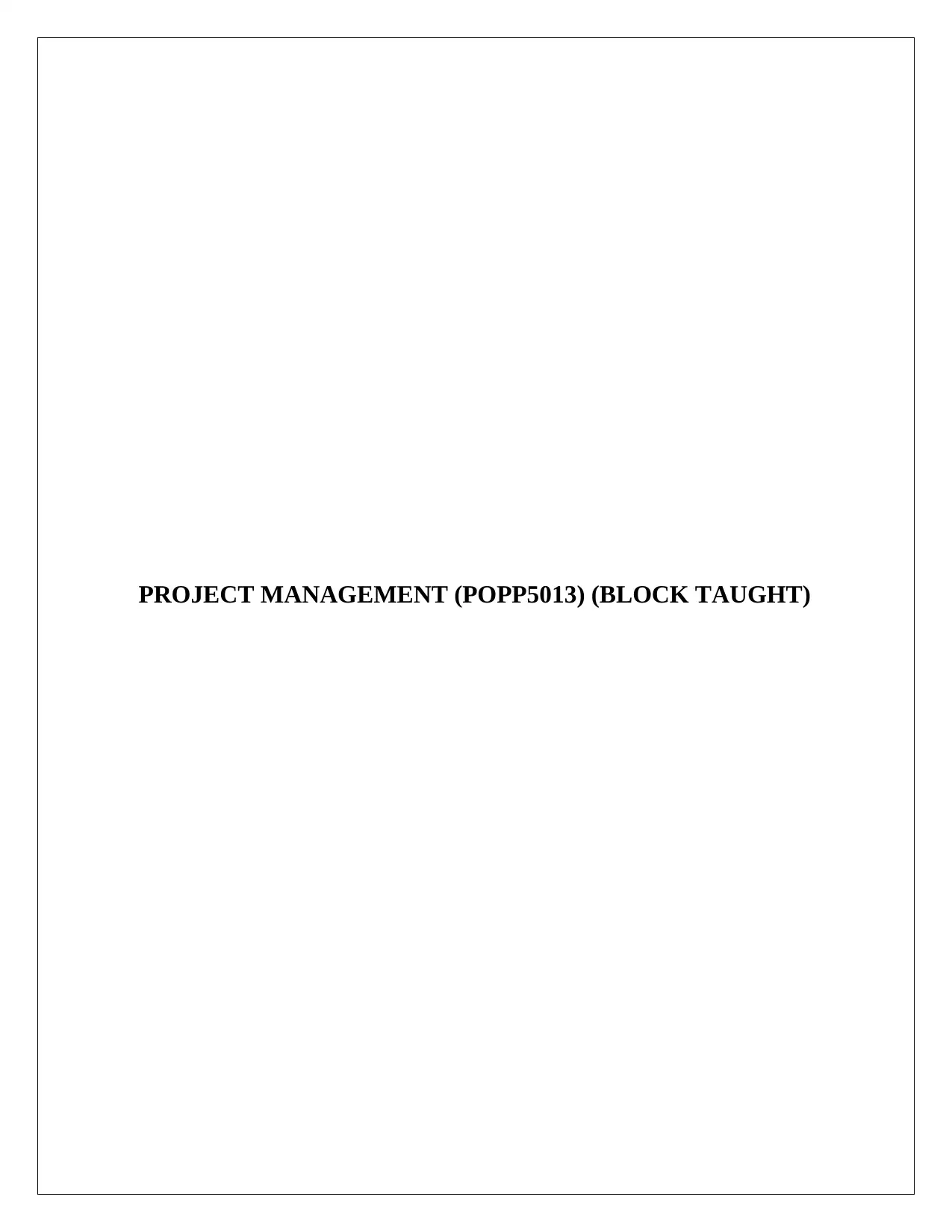
PROJECT MANAGEMENT (POPP5013) (BLOCK TAUGHT)
Paraphrase This Document
Need a fresh take? Get an instant paraphrase of this document with our AI Paraphraser
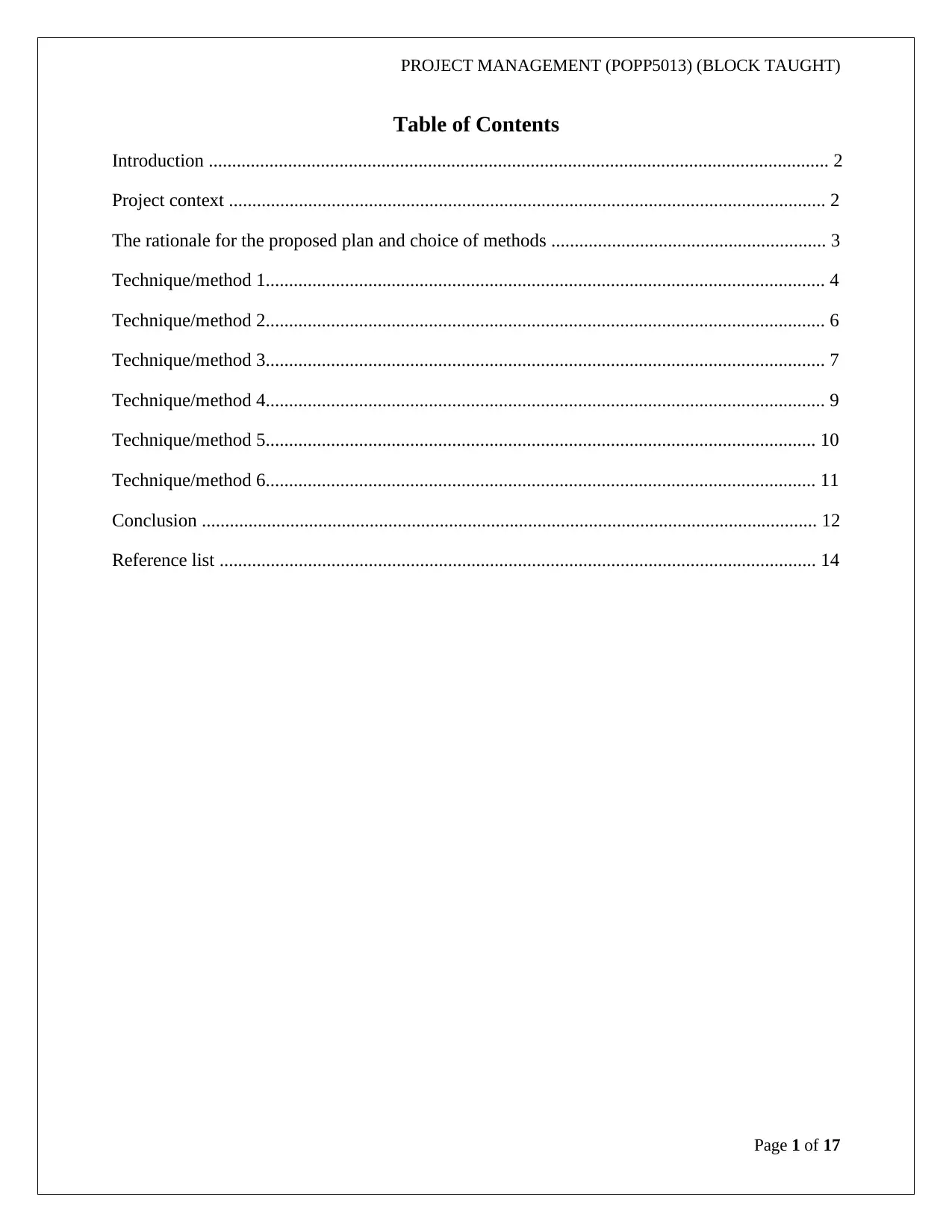
PROJECT MANAGEMENT (POPP5013) (BLOCK TAUGHT)
Page 1 of 17
Table of Contents
Introduction ..................................................................................................................................... 2
Project context ................................................................................................................................ 2
The rationale for the proposed plan and choice of methods ........................................................... 3
Technique/method 1........................................................................................................................ 4
Technique/method 2........................................................................................................................ 6
Technique/method 3........................................................................................................................ 7
Technique/method 4........................................................................................................................ 9
Technique/method 5...................................................................................................................... 10
Technique/method 6...................................................................................................................... 11
Conclusion .................................................................................................................................... 12
Reference list ................................................................................................................................ 14
Page 1 of 17
Table of Contents
Introduction ..................................................................................................................................... 2
Project context ................................................................................................................................ 2
The rationale for the proposed plan and choice of methods ........................................................... 3
Technique/method 1........................................................................................................................ 4
Technique/method 2........................................................................................................................ 6
Technique/method 3........................................................................................................................ 7
Technique/method 4........................................................................................................................ 9
Technique/method 5...................................................................................................................... 10
Technique/method 6...................................................................................................................... 11
Conclusion .................................................................................................................................... 12
Reference list ................................................................................................................................ 14
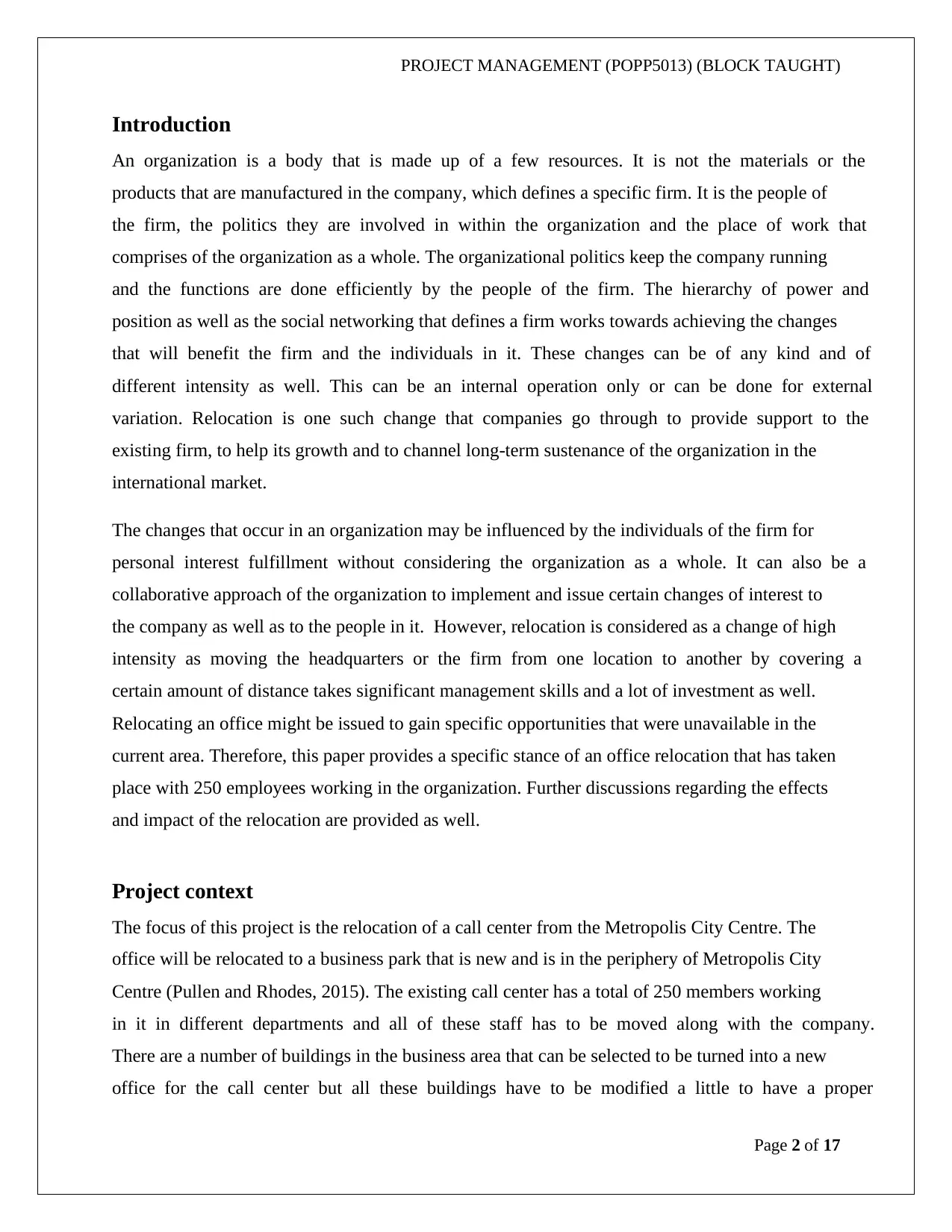
PROJECT MANAGEMENT (POPP5013) (BLOCK TAUGHT)
Page 2 of 17
Introduction
An organization is a body that is made up of a few resources. It is not the materials or the
products that are manufactured in the company, which defines a specific firm. It is the people of
the firm, the politics they are involved in within the organization and the place of work that
comprises of the organization as a whole. The organizational politics keep the company running
and the functions are done efficiently by the people of the firm. The hierarchy of power and
position as well as the social networking that defines a firm works towards achieving the changes
that will benefit the firm and the individuals in it. These changes can be of any kind and of
different intensity as well. This can be an internal operation only or can be done for external
variation. Relocation is one such change that companies go through to provide support to the
existing firm, to help its growth and to channel long-term sustenance of the organization in the
international market.
The changes that occur in an organization may be influenced by the individuals of the firm for
personal interest fulfillment without considering the organization as a whole. It can also be a
collaborative approach of the organization to implement and issue certain changes of interest to
the company as well as to the people in it. However, relocation is considered as a change of high
intensity as moving the headquarters or the firm from one location to another by covering a
certain amount of distance takes significant management skills and a lot of investment as well.
Relocating an office might be issued to gain specific opportunities that were unavailable in the
current area. Therefore, this paper provides a specific stance of an office relocation that has taken
place with 250 employees working in the organization. Further discussions regarding the effects
and impact of the relocation are provided as well.
Project context
The focus of this project is the relocation of a call center from the Metropolis City Centre. The
office will be relocated to a business park that is new and is in the periphery of Metropolis City
Centre (Pullen and Rhodes, 2015). The existing call center has a total of 250 members working
in it in different departments and all of these staff has to be moved along with the company.
There are a number of buildings in the business area that can be selected to be turned into a new
office for the call center but all these buildings have to be modified a little to have a proper
Page 2 of 17
Introduction
An organization is a body that is made up of a few resources. It is not the materials or the
products that are manufactured in the company, which defines a specific firm. It is the people of
the firm, the politics they are involved in within the organization and the place of work that
comprises of the organization as a whole. The organizational politics keep the company running
and the functions are done efficiently by the people of the firm. The hierarchy of power and
position as well as the social networking that defines a firm works towards achieving the changes
that will benefit the firm and the individuals in it. These changes can be of any kind and of
different intensity as well. This can be an internal operation only or can be done for external
variation. Relocation is one such change that companies go through to provide support to the
existing firm, to help its growth and to channel long-term sustenance of the organization in the
international market.
The changes that occur in an organization may be influenced by the individuals of the firm for
personal interest fulfillment without considering the organization as a whole. It can also be a
collaborative approach of the organization to implement and issue certain changes of interest to
the company as well as to the people in it. However, relocation is considered as a change of high
intensity as moving the headquarters or the firm from one location to another by covering a
certain amount of distance takes significant management skills and a lot of investment as well.
Relocating an office might be issued to gain specific opportunities that were unavailable in the
current area. Therefore, this paper provides a specific stance of an office relocation that has taken
place with 250 employees working in the organization. Further discussions regarding the effects
and impact of the relocation are provided as well.
Project context
The focus of this project is the relocation of a call center from the Metropolis City Centre. The
office will be relocated to a business park that is new and is in the periphery of Metropolis City
Centre (Pullen and Rhodes, 2015). The existing call center has a total of 250 members working
in it in different departments and all of these staff has to be moved along with the company.
There are a number of buildings in the business area that can be selected to be turned into a new
office for the call center but all these buildings have to be modified a little to have a proper
⊘ This is a preview!⊘
Do you want full access?
Subscribe today to unlock all pages.

Trusted by 1+ million students worldwide
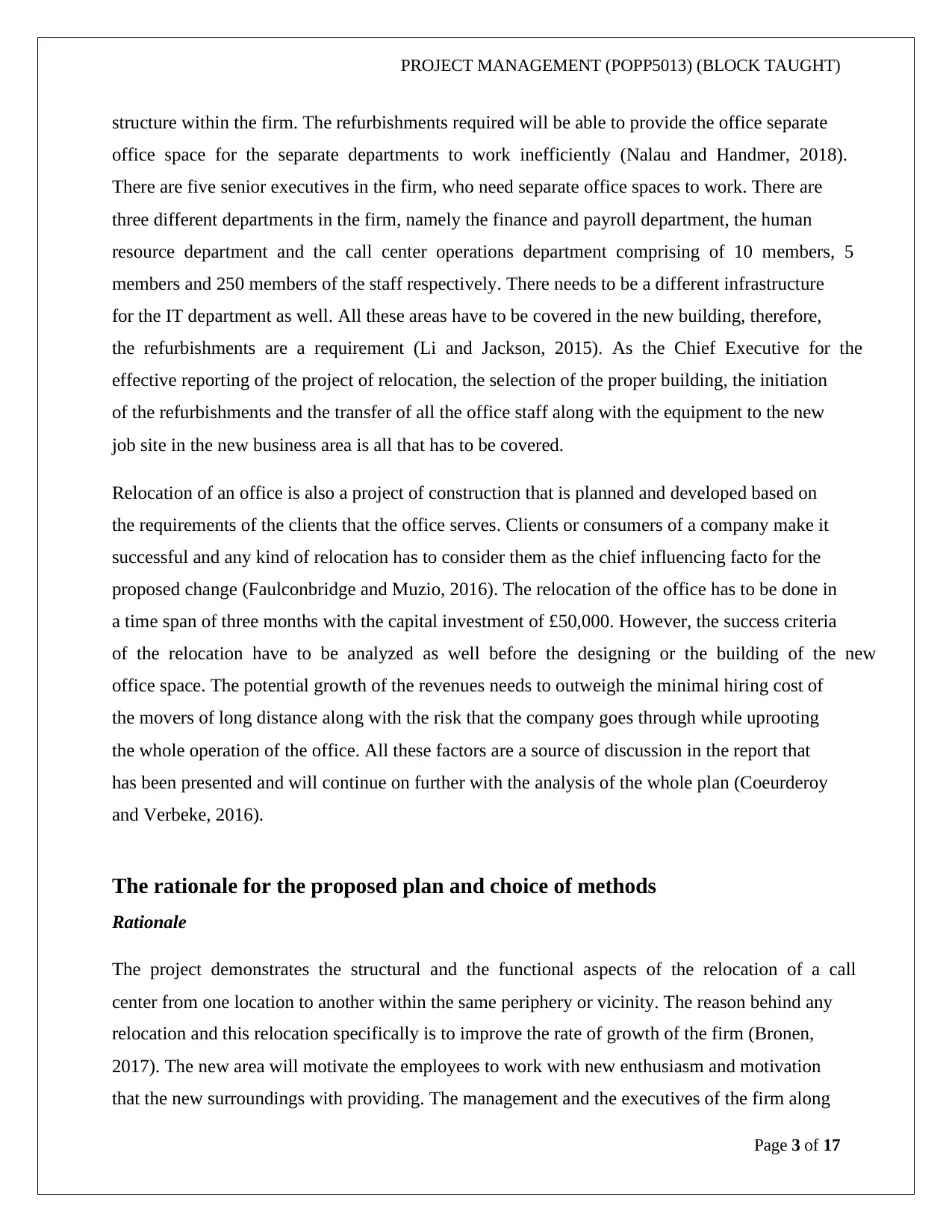
PROJECT MANAGEMENT (POPP5013) (BLOCK TAUGHT)
Page 3 of 17
structure within the firm. The refurbishments required will be able to provide the office separate
office space for the separate departments to work inefficiently (Nalau and Handmer, 2018).
There are five senior executives in the firm, who need separate office spaces to work. There are
three different departments in the firm, namely the finance and payroll department, the human
resource department and the call center operations department comprising of 10 members, 5
members and 250 members of the staff respectively. There needs to be a different infrastructure
for the IT department as well. All these areas have to be covered in the new building, therefore,
the refurbishments are a requirement (Li and Jackson, 2015). As the Chief Executive for the
effective reporting of the project of relocation, the selection of the proper building, the initiation
of the refurbishments and the transfer of all the office staff along with the equipment to the new
job site in the new business area is all that has to be covered.
Relocation of an office is also a project of construction that is planned and developed based on
the requirements of the clients that the office serves. Clients or consumers of a company make it
successful and any kind of relocation has to consider them as the chief influencing facto for the
proposed change (Faulconbridge and Muzio, 2016). The relocation of the office has to be done in
a time span of three months with the capital investment of £50,000. However, the success criteria
of the relocation have to be analyzed as well before the designing or the building of the new
office space. The potential growth of the revenues needs to outweigh the minimal hiring cost of
the movers of long distance along with the risk that the company goes through while uprooting
the whole operation of the office. All these factors are a source of discussion in the report that
has been presented and will continue on further with the analysis of the whole plan (Coeurderoy
and Verbeke, 2016).
The rationale for the proposed plan and choice of methods
Rationale
The project demonstrates the structural and the functional aspects of the relocation of a call
center from one location to another within the same periphery or vicinity. The reason behind any
relocation and this relocation specifically is to improve the rate of growth of the firm (Bronen,
2017). The new area will motivate the employees to work with new enthusiasm and motivation
that the new surroundings with providing. The management and the executives of the firm along
Page 3 of 17
structure within the firm. The refurbishments required will be able to provide the office separate
office space for the separate departments to work inefficiently (Nalau and Handmer, 2018).
There are five senior executives in the firm, who need separate office spaces to work. There are
three different departments in the firm, namely the finance and payroll department, the human
resource department and the call center operations department comprising of 10 members, 5
members and 250 members of the staff respectively. There needs to be a different infrastructure
for the IT department as well. All these areas have to be covered in the new building, therefore,
the refurbishments are a requirement (Li and Jackson, 2015). As the Chief Executive for the
effective reporting of the project of relocation, the selection of the proper building, the initiation
of the refurbishments and the transfer of all the office staff along with the equipment to the new
job site in the new business area is all that has to be covered.
Relocation of an office is also a project of construction that is planned and developed based on
the requirements of the clients that the office serves. Clients or consumers of a company make it
successful and any kind of relocation has to consider them as the chief influencing facto for the
proposed change (Faulconbridge and Muzio, 2016). The relocation of the office has to be done in
a time span of three months with the capital investment of £50,000. However, the success criteria
of the relocation have to be analyzed as well before the designing or the building of the new
office space. The potential growth of the revenues needs to outweigh the minimal hiring cost of
the movers of long distance along with the risk that the company goes through while uprooting
the whole operation of the office. All these factors are a source of discussion in the report that
has been presented and will continue on further with the analysis of the whole plan (Coeurderoy
and Verbeke, 2016).
The rationale for the proposed plan and choice of methods
Rationale
The project demonstrates the structural and the functional aspects of the relocation of a call
center from one location to another within the same periphery or vicinity. The reason behind any
relocation and this relocation specifically is to improve the rate of growth of the firm (Bronen,
2017). The new area will motivate the employees to work with new enthusiasm and motivation
that the new surroundings with providing. The management and the executives of the firm along
Paraphrase This Document
Need a fresh take? Get an instant paraphrase of this document with our AI Paraphraser
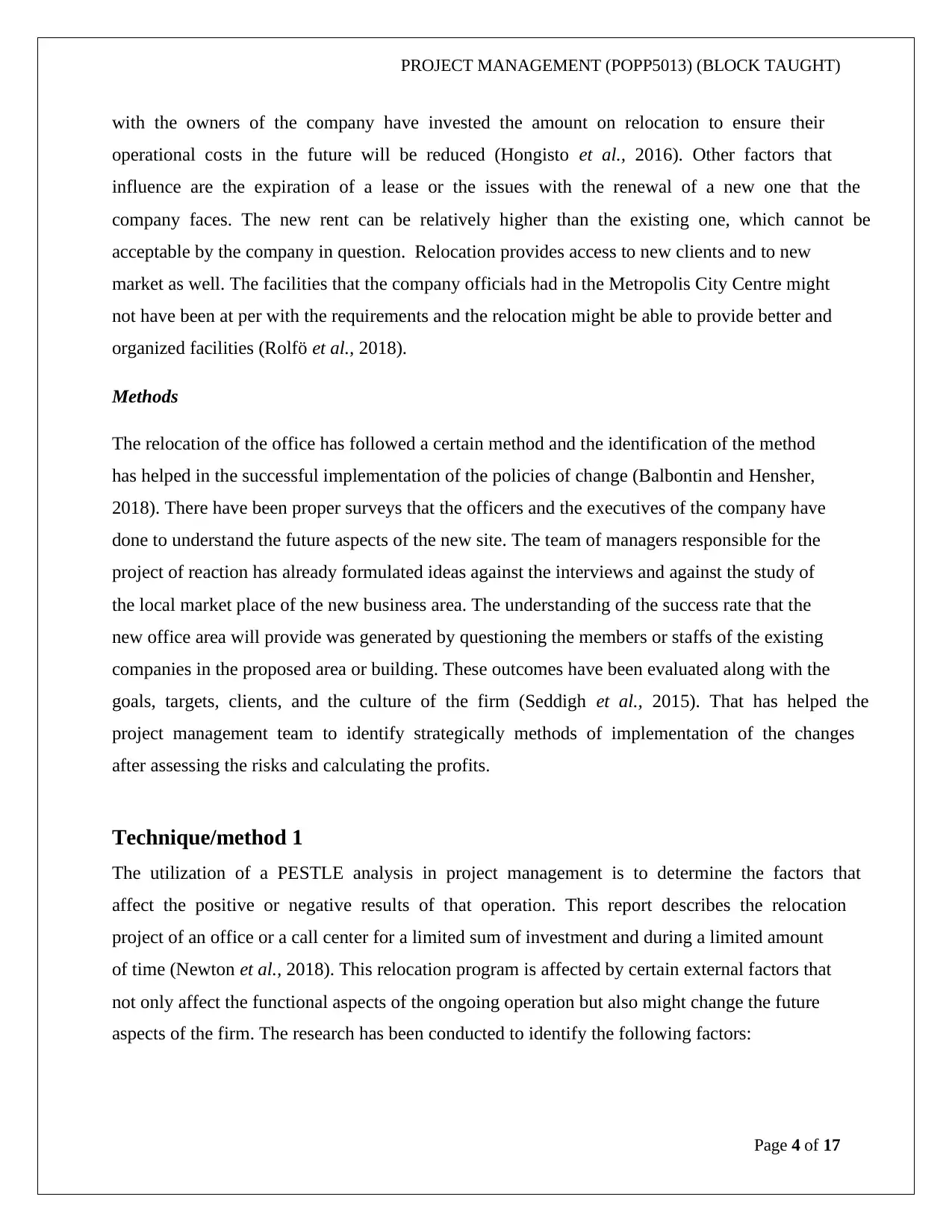
PROJECT MANAGEMENT (POPP5013) (BLOCK TAUGHT)
Page 4 of 17
with the owners of the company have invested the amount on relocation to ensure their
operational costs in the future will be reduced (Hongisto et al., 2016). Other factors that
influence are the expiration of a lease or the issues with the renewal of a new one that the
company faces. The new rent can be relatively higher than the existing one, which cannot be
acceptable by the company in question. Relocation provides access to new clients and to new
market as well. The facilities that the company officials had in the Metropolis City Centre might
not have been at per with the requirements and the relocation might be able to provide better and
organized facilities (Rolfö et al., 2018).
Methods
The relocation of the office has followed a certain method and the identification of the method
has helped in the successful implementation of the policies of change (Balbontin and Hensher,
2018). There have been proper surveys that the officers and the executives of the company have
done to understand the future aspects of the new site. The team of managers responsible for the
project of reaction has already formulated ideas against the interviews and against the study of
the local market place of the new business area. The understanding of the success rate that the
new office area will provide was generated by questioning the members or staffs of the existing
companies in the proposed area or building. These outcomes have been evaluated along with the
goals, targets, clients, and the culture of the firm (Seddigh et al., 2015). That has helped the
project management team to identify strategically methods of implementation of the changes
after assessing the risks and calculating the profits.
Technique/method 1
The utilization of a PESTLE analysis in project management is to determine the factors that
affect the positive or negative results of that operation. This report describes the relocation
project of an office or a call center for a limited sum of investment and during a limited amount
of time (Newton et al., 2018). This relocation program is affected by certain external factors that
not only affect the functional aspects of the ongoing operation but also might change the future
aspects of the firm. The research has been conducted to identify the following factors:
Page 4 of 17
with the owners of the company have invested the amount on relocation to ensure their
operational costs in the future will be reduced (Hongisto et al., 2016). Other factors that
influence are the expiration of a lease or the issues with the renewal of a new one that the
company faces. The new rent can be relatively higher than the existing one, which cannot be
acceptable by the company in question. Relocation provides access to new clients and to new
market as well. The facilities that the company officials had in the Metropolis City Centre might
not have been at per with the requirements and the relocation might be able to provide better and
organized facilities (Rolfö et al., 2018).
Methods
The relocation of the office has followed a certain method and the identification of the method
has helped in the successful implementation of the policies of change (Balbontin and Hensher,
2018). There have been proper surveys that the officers and the executives of the company have
done to understand the future aspects of the new site. The team of managers responsible for the
project of reaction has already formulated ideas against the interviews and against the study of
the local market place of the new business area. The understanding of the success rate that the
new office area will provide was generated by questioning the members or staffs of the existing
companies in the proposed area or building. These outcomes have been evaluated along with the
goals, targets, clients, and the culture of the firm (Seddigh et al., 2015). That has helped the
project management team to identify strategically methods of implementation of the changes
after assessing the risks and calculating the profits.
Technique/method 1
The utilization of a PESTLE analysis in project management is to determine the factors that
affect the positive or negative results of that operation. This report describes the relocation
project of an office or a call center for a limited sum of investment and during a limited amount
of time (Newton et al., 2018). This relocation program is affected by certain external factors that
not only affect the functional aspects of the ongoing operation but also might change the future
aspects of the firm. The research has been conducted to identify the following factors:
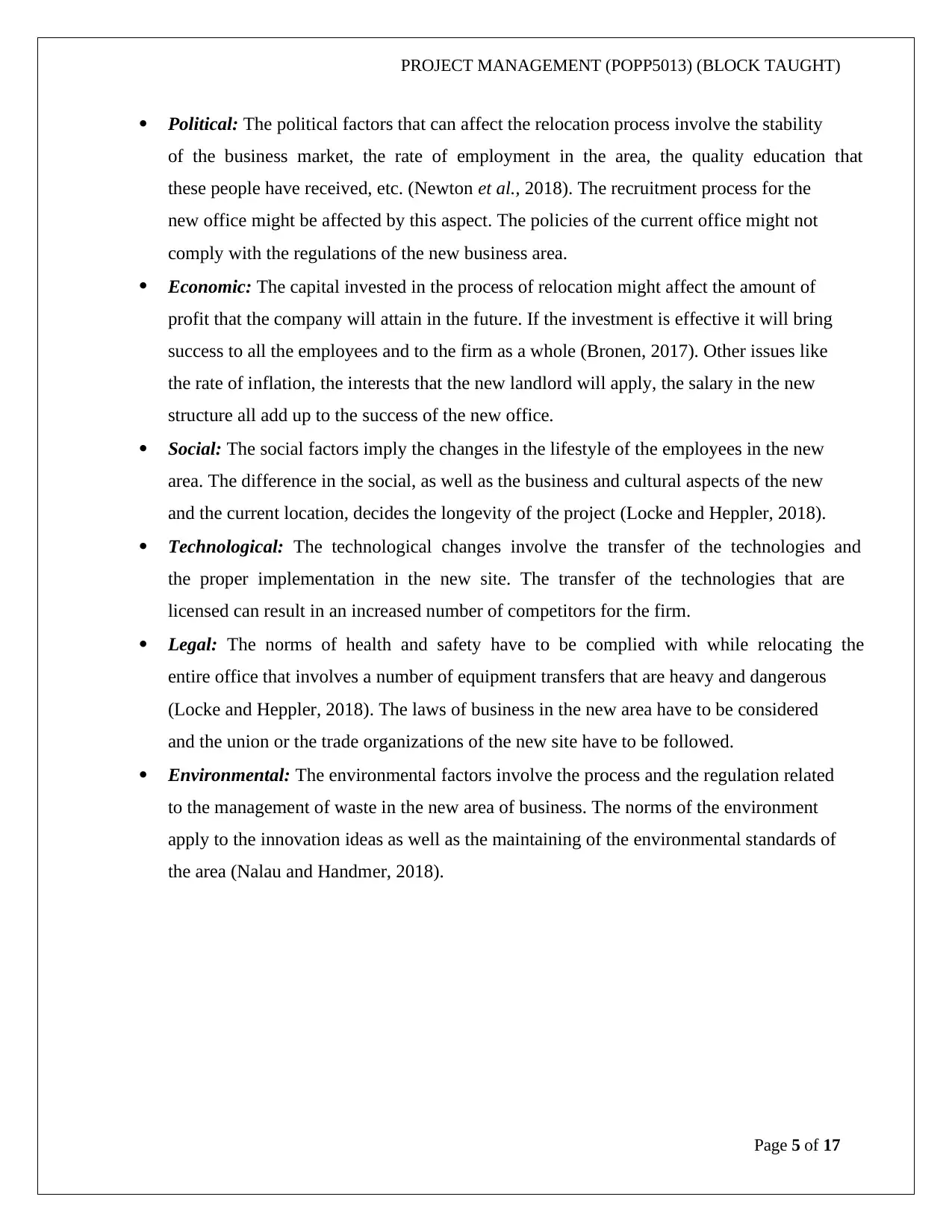
PROJECT MANAGEMENT (POPP5013) (BLOCK TAUGHT)
Page 5 of 17
Political: The political factors that can affect the relocation process involve the stability
of the business market, the rate of employment in the area, the quality education that
these people have received, etc. (Newton et al., 2018). The recruitment process for the
new office might be affected by this aspect. The policies of the current office might not
comply with the regulations of the new business area.
Economic: The capital invested in the process of relocation might affect the amount of
profit that the company will attain in the future. If the investment is effective it will bring
success to all the employees and to the firm as a whole (Bronen, 2017). Other issues like
the rate of inflation, the interests that the new landlord will apply, the salary in the new
structure all add up to the success of the new office.
Social: The social factors imply the changes in the lifestyle of the employees in the new
area. The difference in the social, as well as the business and cultural aspects of the new
and the current location, decides the longevity of the project (Locke and Heppler, 2018).
Technological: The technological changes involve the transfer of the technologies and
the proper implementation in the new site. The transfer of the technologies that are
licensed can result in an increased number of competitors for the firm.
Legal: The norms of health and safety have to be complied with while relocating the
entire office that involves a number of equipment transfers that are heavy and dangerous
(Locke and Heppler, 2018). The laws of business in the new area have to be considered
and the union or the trade organizations of the new site have to be followed.
Environmental: The environmental factors involve the process and the regulation related
to the management of waste in the new area of business. The norms of the environment
apply to the innovation ideas as well as the maintaining of the environmental standards of
the area (Nalau and Handmer, 2018).
Page 5 of 17
Political: The political factors that can affect the relocation process involve the stability
of the business market, the rate of employment in the area, the quality education that
these people have received, etc. (Newton et al., 2018). The recruitment process for the
new office might be affected by this aspect. The policies of the current office might not
comply with the regulations of the new business area.
Economic: The capital invested in the process of relocation might affect the amount of
profit that the company will attain in the future. If the investment is effective it will bring
success to all the employees and to the firm as a whole (Bronen, 2017). Other issues like
the rate of inflation, the interests that the new landlord will apply, the salary in the new
structure all add up to the success of the new office.
Social: The social factors imply the changes in the lifestyle of the employees in the new
area. The difference in the social, as well as the business and cultural aspects of the new
and the current location, decides the longevity of the project (Locke and Heppler, 2018).
Technological: The technological changes involve the transfer of the technologies and
the proper implementation in the new site. The transfer of the technologies that are
licensed can result in an increased number of competitors for the firm.
Legal: The norms of health and safety have to be complied with while relocating the
entire office that involves a number of equipment transfers that are heavy and dangerous
(Locke and Heppler, 2018). The laws of business in the new area have to be considered
and the union or the trade organizations of the new site have to be followed.
Environmental: The environmental factors involve the process and the regulation related
to the management of waste in the new area of business. The norms of the environment
apply to the innovation ideas as well as the maintaining of the environmental standards of
the area (Nalau and Handmer, 2018).
⊘ This is a preview!⊘
Do you want full access?
Subscribe today to unlock all pages.

Trusted by 1+ million students worldwide
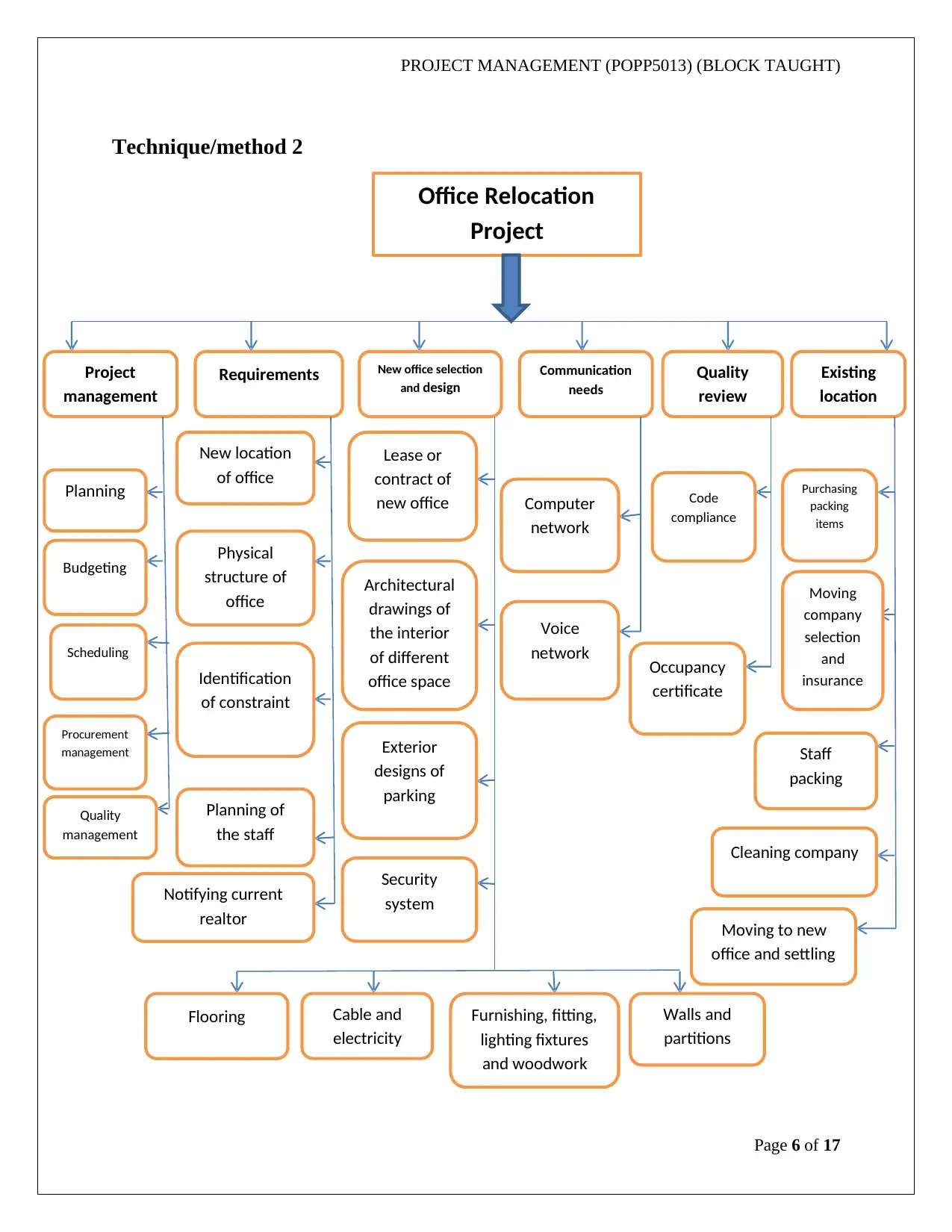
PROJECT MANAGEMENT (POPP5013) (BLOCK TAUGHT)
Page 6 of 17
Technique/method 2
Office Relocation
Project
Project
management
Requirements New office selection
and design
Communication
needs
Quality
review
Existing
location
Planning
Budgeting
Scheduling
Procurement
management
Quality
management
New location
of office
Physical
structure of
office
Identification
of constraint
Planning of
the staff
Notifying current
realtor
Flooring Cable and
electricity
Furnishing, fitting,
lighting fixtures
and woodwork
Walls and
partitions
Security
system
Exterior
designs of
parking
Architectural
drawings of
the interior
of different
office space
Lease or
contract of
new office Computer
network
Voice
network
Code
compliance
Occupancy
certificate
Purchasing
packing
items
Moving
company
selection
and
insurance
Staff
packing
Cleaning company
Moving to new
office and settling
Page 6 of 17
Technique/method 2
Office Relocation
Project
Project
management
Requirements New office selection
and design
Communication
needs
Quality
review
Existing
location
Planning
Budgeting
Scheduling
Procurement
management
Quality
management
New location
of office
Physical
structure of
office
Identification
of constraint
Planning of
the staff
Notifying current
realtor
Flooring Cable and
electricity
Furnishing, fitting,
lighting fixtures
and woodwork
Walls and
partitions
Security
system
Exterior
designs of
parking
Architectural
drawings of
the interior
of different
office space
Lease or
contract of
new office Computer
network
Voice
network
Code
compliance
Occupancy
certificate
Purchasing
packing
items
Moving
company
selection
and
insurance
Staff
packing
Cleaning company
Moving to new
office and settling
Paraphrase This Document
Need a fresh take? Get an instant paraphrase of this document with our AI Paraphraser
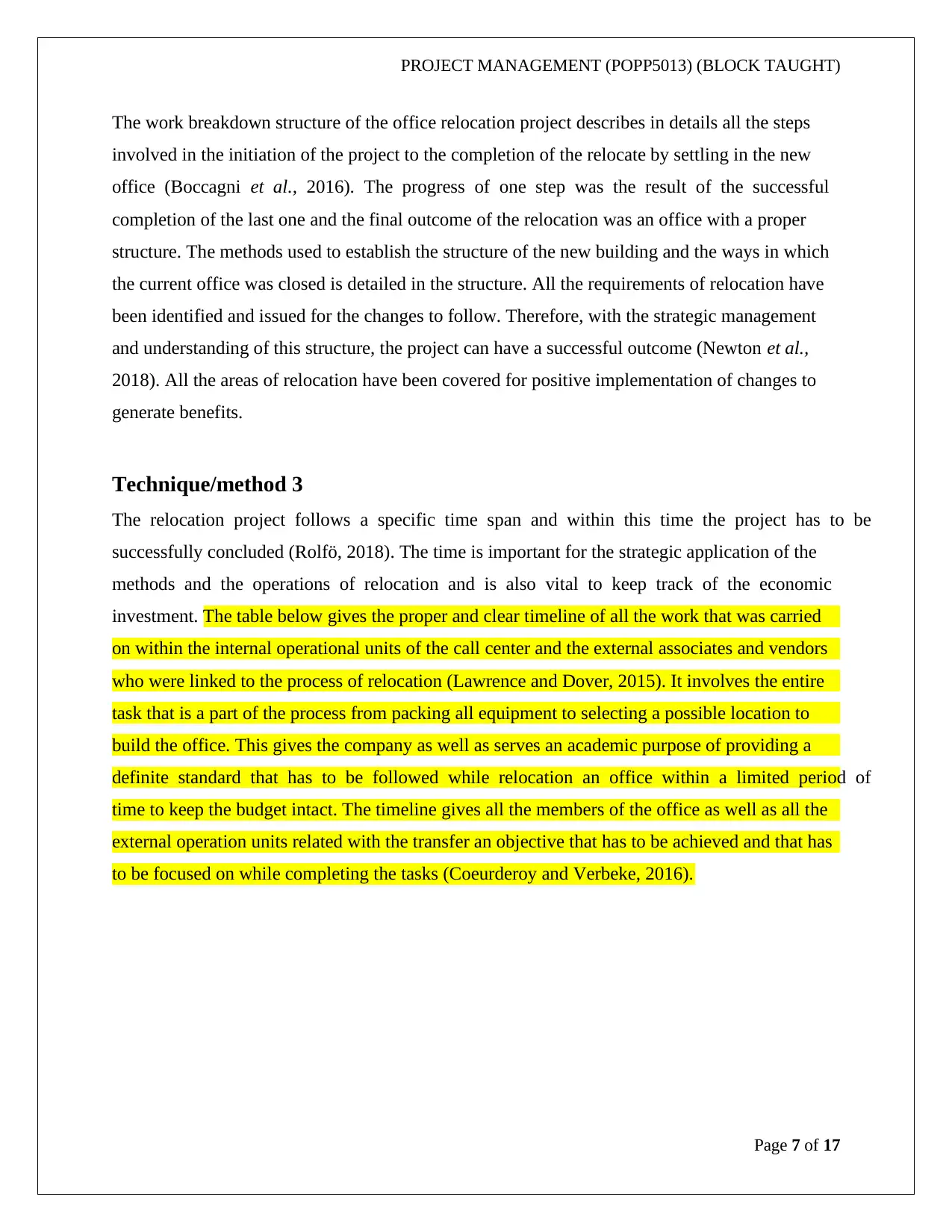
PROJECT MANAGEMENT (POPP5013) (BLOCK TAUGHT)
Page 7 of 17
The work breakdown structure of the office relocation project describes in details all the steps
involved in the initiation of the project to the completion of the relocate by settling in the new
office (Boccagni et al., 2016). The progress of one step was the result of the successful
completion of the last one and the final outcome of the relocation was an office with a proper
structure. The methods used to establish the structure of the new building and the ways in which
the current office was closed is detailed in the structure. All the requirements of relocation have
been identified and issued for the changes to follow. Therefore, with the strategic management
and understanding of this structure, the project can have a successful outcome (Newton et al.,
2018). All the areas of relocation have been covered for positive implementation of changes to
generate benefits.
Technique/method 3
The relocation project follows a specific time span and within this time the project has to be
successfully concluded (Rolfö, 2018). The time is important for the strategic application of the
methods and the operations of relocation and is also vital to keep track of the economic
investment. The table below gives the proper and clear timeline of all the work that was carried
on within the internal operational units of the call center and the external associates and vendors
who were linked to the process of relocation (Lawrence and Dover, 2015). It involves the entire
task that is a part of the process from packing all equipment to selecting a possible location to
build the office. This gives the company as well as serves an academic purpose of providing a
definite standard that has to be followed while relocation an office within a limited period of
time to keep the budget intact. The timeline gives all the members of the office as well as all the
external operation units related with the transfer an objective that has to be achieved and that has
to be focused on while completing the tasks (Coeurderoy and Verbeke, 2016).
Page 7 of 17
The work breakdown structure of the office relocation project describes in details all the steps
involved in the initiation of the project to the completion of the relocate by settling in the new
office (Boccagni et al., 2016). The progress of one step was the result of the successful
completion of the last one and the final outcome of the relocation was an office with a proper
structure. The methods used to establish the structure of the new building and the ways in which
the current office was closed is detailed in the structure. All the requirements of relocation have
been identified and issued for the changes to follow. Therefore, with the strategic management
and understanding of this structure, the project can have a successful outcome (Newton et al.,
2018). All the areas of relocation have been covered for positive implementation of changes to
generate benefits.
Technique/method 3
The relocation project follows a specific time span and within this time the project has to be
successfully concluded (Rolfö, 2018). The time is important for the strategic application of the
methods and the operations of relocation and is also vital to keep track of the economic
investment. The table below gives the proper and clear timeline of all the work that was carried
on within the internal operational units of the call center and the external associates and vendors
who were linked to the process of relocation (Lawrence and Dover, 2015). It involves the entire
task that is a part of the process from packing all equipment to selecting a possible location to
build the office. This gives the company as well as serves an academic purpose of providing a
definite standard that has to be followed while relocation an office within a limited period of
time to keep the budget intact. The timeline gives all the members of the office as well as all the
external operation units related with the transfer an objective that has to be achieved and that has
to be focused on while completing the tasks (Coeurderoy and Verbeke, 2016).
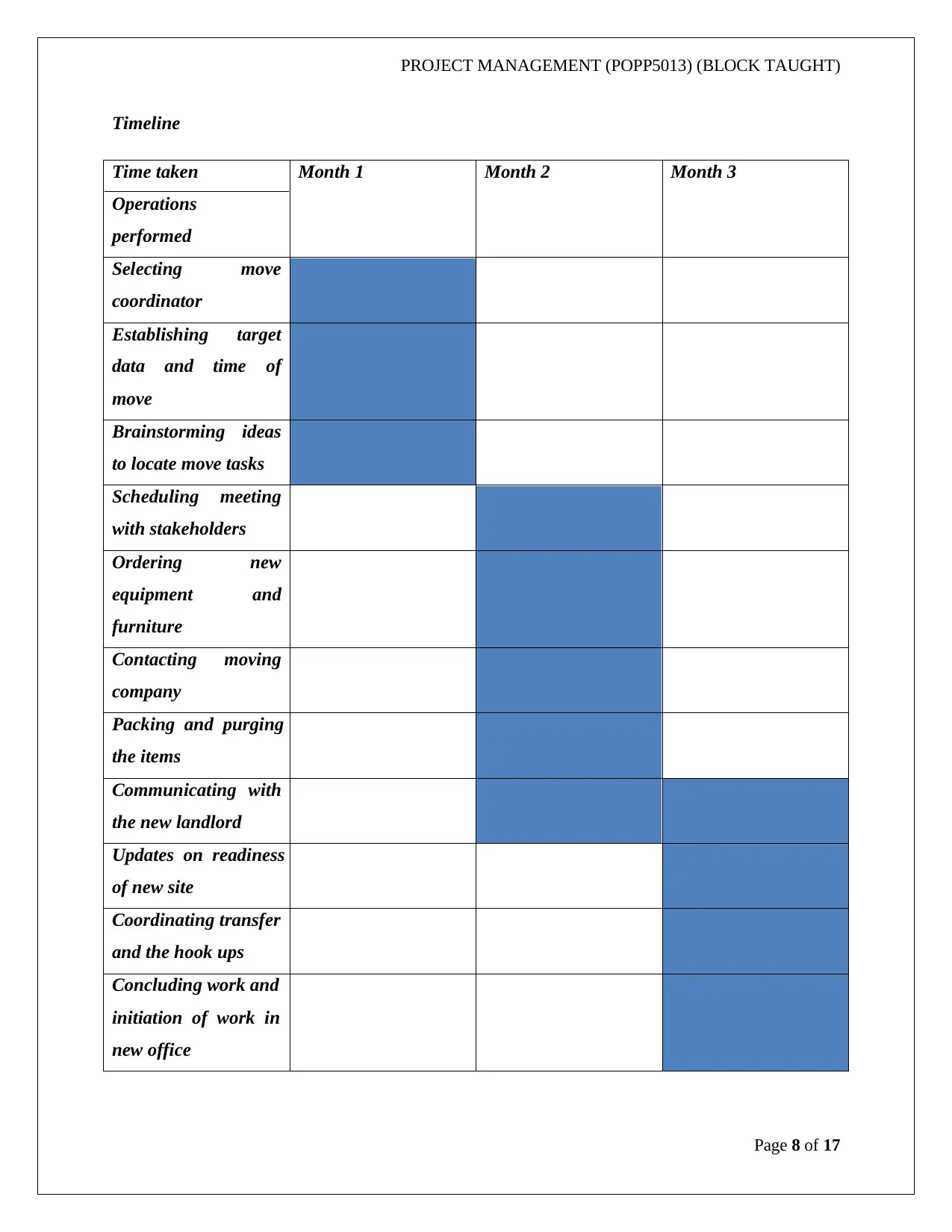
PROJECT MANAGEMENT (POPP5013) (BLOCK TAUGHT)
Page 8 of 17
Timeline
Time taken
Operations
performed
Month 1 Month 2 Month 3
Selecting move
coordinator
Establishing target
data and time of
move
Brainstorming ideas
to locate move tasks
Scheduling meeting
with stakeholders
Ordering new
equipment and
furniture
Contacting moving
company
Packing and purging
the items
Communicating with
the new landlord
Updates on readiness
of new site
Coordinating transfer
and the hook ups
Concluding work and
initiation of work in
new office
Page 8 of 17
Timeline
Time taken
Operations
performed
Month 1 Month 2 Month 3
Selecting move
coordinator
Establishing target
data and time of
move
Brainstorming ideas
to locate move tasks
Scheduling meeting
with stakeholders
Ordering new
equipment and
furniture
Contacting moving
company
Packing and purging
the items
Communicating with
the new landlord
Updates on readiness
of new site
Coordinating transfer
and the hook ups
Concluding work and
initiation of work in
new office
⊘ This is a preview!⊘
Do you want full access?
Subscribe today to unlock all pages.

Trusted by 1+ million students worldwide
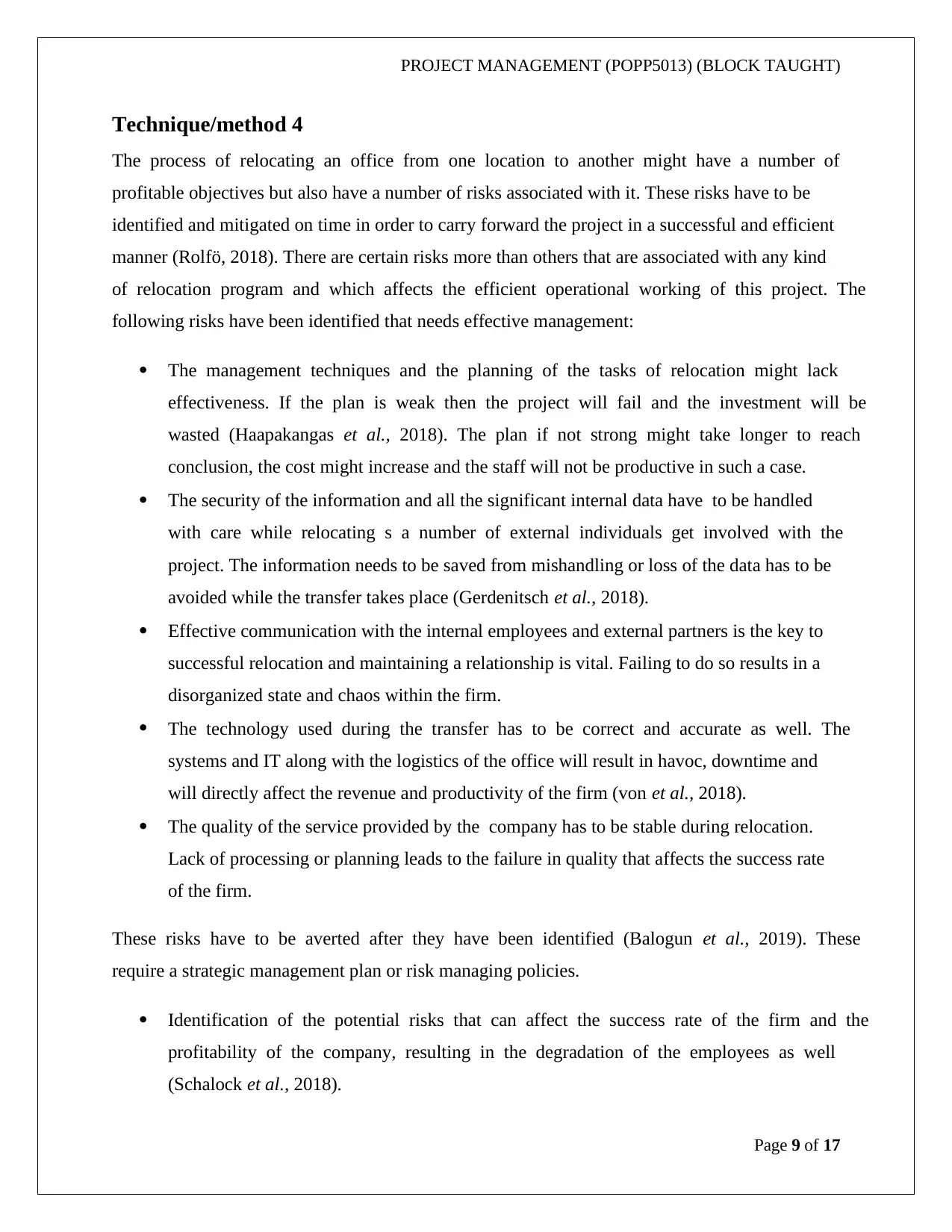
PROJECT MANAGEMENT (POPP5013) (BLOCK TAUGHT)
Page 9 of 17
Technique/method 4
The process of relocating an office from one location to another might have a number of
profitable objectives but also have a number of risks associated with it. These risks have to be
identified and mitigated on time in order to carry forward the project in a successful and efficient
manner (Rolfö, 2018). There are certain risks more than others that are associated with any kind
of relocation program and which affects the efficient operational working of this project. The
following risks have been identified that needs effective management:
The management techniques and the planning of the tasks of relocation might lack
effectiveness. If the plan is weak then the project will fail and the investment will be
wasted (Haapakangas et al., 2018). The plan if not strong might take longer to reach
conclusion, the cost might increase and the staff will not be productive in such a case.
The security of the information and all the significant internal data have to be handled
with care while relocating s a number of external individuals get involved with the
project. The information needs to be saved from mishandling or loss of the data has to be
avoided while the transfer takes place (Gerdenitsch et al., 2018).
Effective communication with the internal employees and external partners is the key to
successful relocation and maintaining a relationship is vital. Failing to do so results in a
disorganized state and chaos within the firm.
The technology used during the transfer has to be correct and accurate as well. The
systems and IT along with the logistics of the office will result in havoc, downtime and
will directly affect the revenue and productivity of the firm (von et al., 2018).
The quality of the service provided by the company has to be stable during relocation.
Lack of processing or planning leads to the failure in quality that affects the success rate
of the firm.
These risks have to be averted after they have been identified (Balogun et al., 2019). These
require a strategic management plan or risk managing policies.
Identification of the potential risks that can affect the success rate of the firm and the
profitability of the company, resulting in the degradation of the employees as well
(Schalock et al., 2018).
Page 9 of 17
Technique/method 4
The process of relocating an office from one location to another might have a number of
profitable objectives but also have a number of risks associated with it. These risks have to be
identified and mitigated on time in order to carry forward the project in a successful and efficient
manner (Rolfö, 2018). There are certain risks more than others that are associated with any kind
of relocation program and which affects the efficient operational working of this project. The
following risks have been identified that needs effective management:
The management techniques and the planning of the tasks of relocation might lack
effectiveness. If the plan is weak then the project will fail and the investment will be
wasted (Haapakangas et al., 2018). The plan if not strong might take longer to reach
conclusion, the cost might increase and the staff will not be productive in such a case.
The security of the information and all the significant internal data have to be handled
with care while relocating s a number of external individuals get involved with the
project. The information needs to be saved from mishandling or loss of the data has to be
avoided while the transfer takes place (Gerdenitsch et al., 2018).
Effective communication with the internal employees and external partners is the key to
successful relocation and maintaining a relationship is vital. Failing to do so results in a
disorganized state and chaos within the firm.
The technology used during the transfer has to be correct and accurate as well. The
systems and IT along with the logistics of the office will result in havoc, downtime and
will directly affect the revenue and productivity of the firm (von et al., 2018).
The quality of the service provided by the company has to be stable during relocation.
Lack of processing or planning leads to the failure in quality that affects the success rate
of the firm.
These risks have to be averted after they have been identified (Balogun et al., 2019). These
require a strategic management plan or risk managing policies.
Identification of the potential risks that can affect the success rate of the firm and the
profitability of the company, resulting in the degradation of the employees as well
(Schalock et al., 2018).
Paraphrase This Document
Need a fresh take? Get an instant paraphrase of this document with our AI Paraphraser
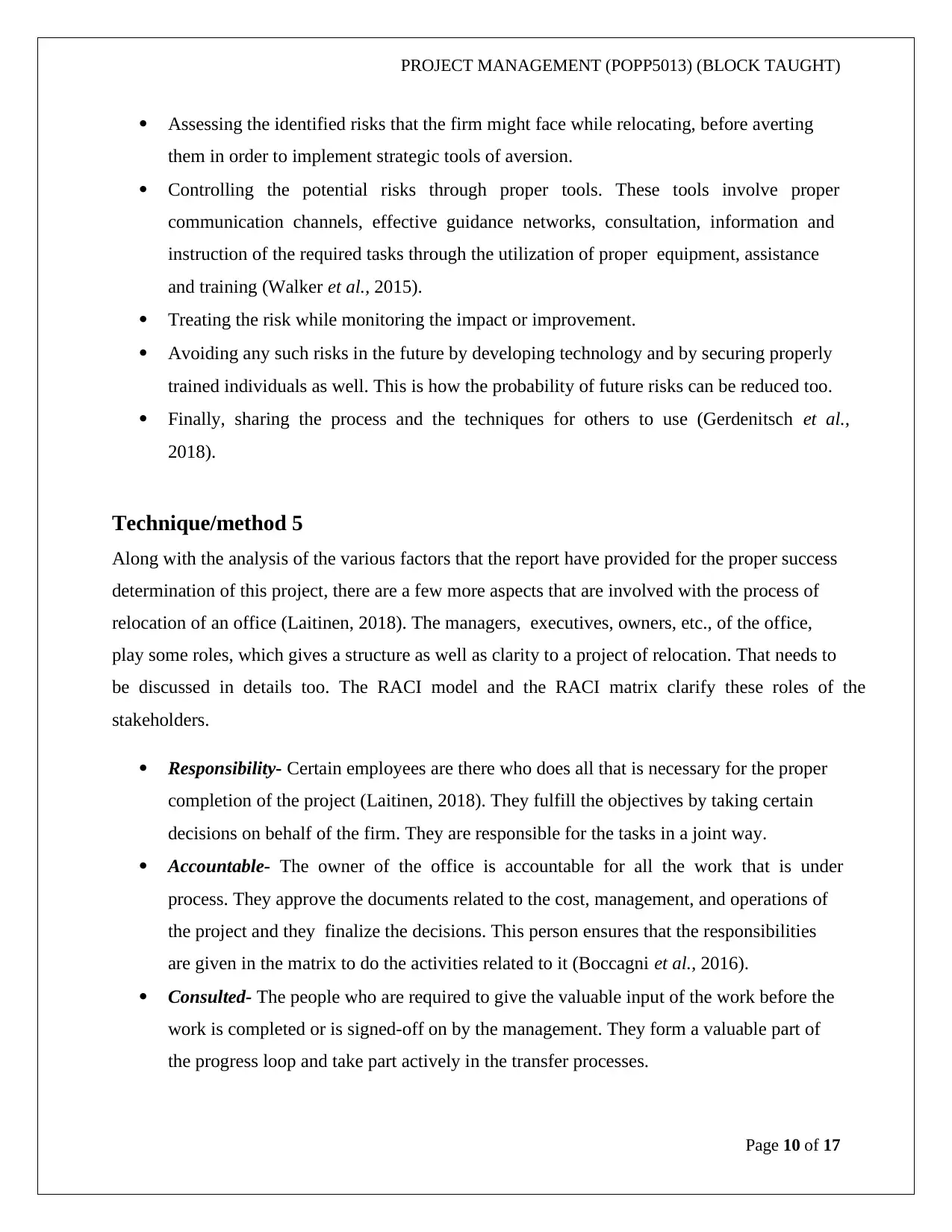
PROJECT MANAGEMENT (POPP5013) (BLOCK TAUGHT)
Page 10 of 17
Assessing the identified risks that the firm might face while relocating, before averting
them in order to implement strategic tools of aversion.
Controlling the potential risks through proper tools. These tools involve proper
communication channels, effective guidance networks, consultation, information and
instruction of the required tasks through the utilization of proper equipment, assistance
and training (Walker et al., 2015).
Treating the risk while monitoring the impact or improvement.
Avoiding any such risks in the future by developing technology and by securing properly
trained individuals as well. This is how the probability of future risks can be reduced too.
Finally, sharing the process and the techniques for others to use (Gerdenitsch et al.,
2018).
Technique/method 5
Along with the analysis of the various factors that the report have provided for the proper success
determination of this project, there are a few more aspects that are involved with the process of
relocation of an office (Laitinen, 2018). The managers, executives, owners, etc., of the office,
play some roles, which gives a structure as well as clarity to a project of relocation. That needs to
be discussed in details too. The RACI model and the RACI matrix clarify these roles of the
stakeholders.
Responsibility- Certain employees are there who does all that is necessary for the proper
completion of the project (Laitinen, 2018). They fulfill the objectives by taking certain
decisions on behalf of the firm. They are responsible for the tasks in a joint way.
Accountable- The owner of the office is accountable for all the work that is under
process. They approve the documents related to the cost, management, and operations of
the project and they finalize the decisions. This person ensures that the responsibilities
are given in the matrix to do the activities related to it (Boccagni et al., 2016).
Consulted- The people who are required to give the valuable input of the work before the
work is completed or is signed-off on by the management. They form a valuable part of
the progress loop and take part actively in the transfer processes.
Page 10 of 17
Assessing the identified risks that the firm might face while relocating, before averting
them in order to implement strategic tools of aversion.
Controlling the potential risks through proper tools. These tools involve proper
communication channels, effective guidance networks, consultation, information and
instruction of the required tasks through the utilization of proper equipment, assistance
and training (Walker et al., 2015).
Treating the risk while monitoring the impact or improvement.
Avoiding any such risks in the future by developing technology and by securing properly
trained individuals as well. This is how the probability of future risks can be reduced too.
Finally, sharing the process and the techniques for others to use (Gerdenitsch et al.,
2018).
Technique/method 5
Along with the analysis of the various factors that the report have provided for the proper success
determination of this project, there are a few more aspects that are involved with the process of
relocation of an office (Laitinen, 2018). The managers, executives, owners, etc., of the office,
play some roles, which gives a structure as well as clarity to a project of relocation. That needs to
be discussed in details too. The RACI model and the RACI matrix clarify these roles of the
stakeholders.
Responsibility- Certain employees are there who does all that is necessary for the proper
completion of the project (Laitinen, 2018). They fulfill the objectives by taking certain
decisions on behalf of the firm. They are responsible for the tasks in a joint way.
Accountable- The owner of the office is accountable for all the work that is under
process. They approve the documents related to the cost, management, and operations of
the project and they finalize the decisions. This person ensures that the responsibilities
are given in the matrix to do the activities related to it (Boccagni et al., 2016).
Consulted- The people who are required to give the valuable input of the work before the
work is completed or is signed-off on by the management. They form a valuable part of
the progress loop and take part actively in the transfer processes.
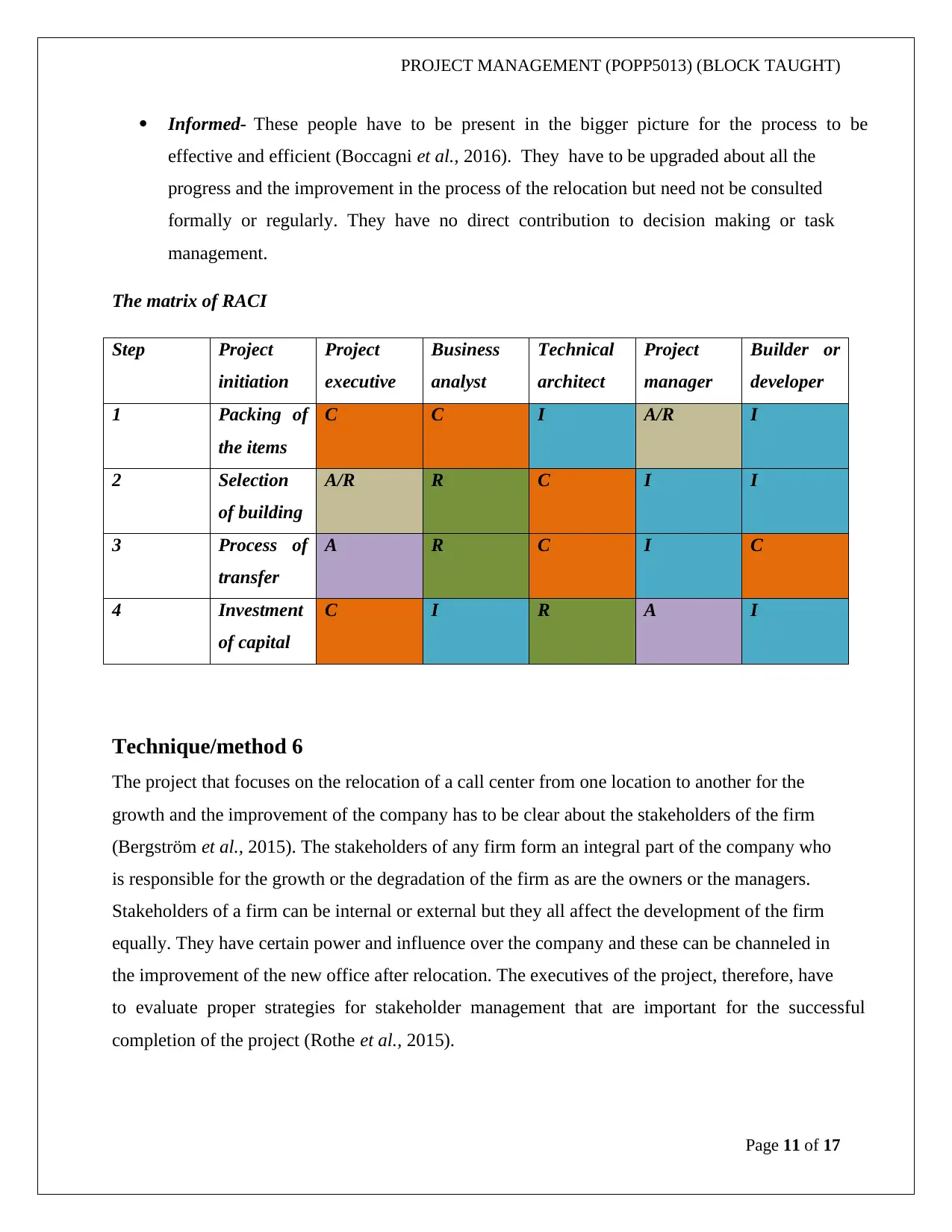
PROJECT MANAGEMENT (POPP5013) (BLOCK TAUGHT)
Page 11 of 17
Informed- These people have to be present in the bigger picture for the process to be
effective and efficient (Boccagni et al., 2016). They have to be upgraded about all the
progress and the improvement in the process of the relocation but need not be consulted
formally or regularly. They have no direct contribution to decision making or task
management.
The matrix of RACI
Step Project
initiation
Project
executive
Business
analyst
Technical
architect
Project
manager
Builder or
developer
1 Packing of
the items
C C I A/R I
2 Selection
of building
A/R R C I I
3 Process of
transfer
A R C I C
4 Investment
of capital
C I R A I
Technique/method 6
The project that focuses on the relocation of a call center from one location to another for the
growth and the improvement of the company has to be clear about the stakeholders of the firm
(Bergström et al., 2015). The stakeholders of any firm form an integral part of the company who
is responsible for the growth or the degradation of the firm as are the owners or the managers.
Stakeholders of a firm can be internal or external but they all affect the development of the firm
equally. They have certain power and influence over the company and these can be channeled in
the improvement of the new office after relocation. The executives of the project, therefore, have
to evaluate proper strategies for stakeholder management that are important for the successful
completion of the project (Rothe et al., 2015).
Page 11 of 17
Informed- These people have to be present in the bigger picture for the process to be
effective and efficient (Boccagni et al., 2016). They have to be upgraded about all the
progress and the improvement in the process of the relocation but need not be consulted
formally or regularly. They have no direct contribution to decision making or task
management.
The matrix of RACI
Step Project
initiation
Project
executive
Business
analyst
Technical
architect
Project
manager
Builder or
developer
1 Packing of
the items
C C I A/R I
2 Selection
of building
A/R R C I I
3 Process of
transfer
A R C I C
4 Investment
of capital
C I R A I
Technique/method 6
The project that focuses on the relocation of a call center from one location to another for the
growth and the improvement of the company has to be clear about the stakeholders of the firm
(Bergström et al., 2015). The stakeholders of any firm form an integral part of the company who
is responsible for the growth or the degradation of the firm as are the owners or the managers.
Stakeholders of a firm can be internal or external but they all affect the development of the firm
equally. They have certain power and influence over the company and these can be channeled in
the improvement of the new office after relocation. The executives of the project, therefore, have
to evaluate proper strategies for stakeholder management that are important for the successful
completion of the project (Rothe et al., 2015).
⊘ This is a preview!⊘
Do you want full access?
Subscribe today to unlock all pages.

Trusted by 1+ million students worldwide
1 out of 17
Related Documents
Your All-in-One AI-Powered Toolkit for Academic Success.
+13062052269
info@desklib.com
Available 24*7 on WhatsApp / Email
![[object Object]](/_next/static/media/star-bottom.7253800d.svg)
Unlock your academic potential
Copyright © 2020–2025 A2Z Services. All Rights Reserved. Developed and managed by ZUCOL.





